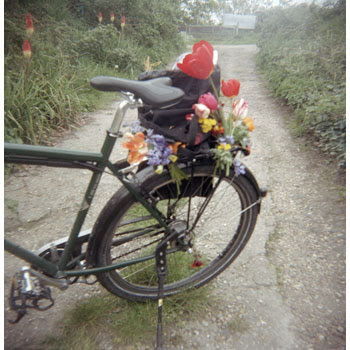

"When burying my first batch of photographs, a passing man spotted me and asked what I was doing. Not only did I not want to give the location away of some of my buried pictures, but It just sounded a bit weird to say that I was burying photographs so replied that I was looking for newts. As soon as I’d said that I looked down and saw a newt at my feet."
'The photographs in this book were taken in Hackney Wick and later buried there. The amount of time the images were left undergournd varied depending on the amount of rainfall. The depths that pictures were buried at also varied, as did their positioning. Sometimes they were facing each other, sometimes back to back or sometimes buried singly.'Not knowing what an image would look like once it was dug up introduced an element of chance and surprise that I found appealing. This feeling of letting go and collaborating with place - allowing it also to work on putting the finishing touches to a picture - felt fair. Maybe the spirit of the place can also make its mark.

"Stephen Gill has again used his surroundings as the inspiration for this beautiful and evocative series. Hackney Flowers has evolved from his series and book Hackney Wick. This times Gill has collected flowers, seeds, berries and objects from Hackney, East London, that were then pressed in his studio and re-photographed alongside his own photographs and found ephemera, thus building up multi-layered images extracted from the area.
Some of the base photographs were also buried in Hackney Wick, allowing the subsequent decay to imprint upon the images, stressing this collaboration with place. A parallel series also runs within this finely produced volume, showing members of the public in Hackney with floral details on their person. This is a warm, poetic and visually exciting book containing images that leave an overwhelming sense of colour, emotion and rhythm extracted from a single borough of London."

"Stephen Gill has learnt this: to haunt the places that haunt him. His photo-accumulations demonstrate a tender vision factored out of experience; alert, watchful, not overeager, wary of that mendacious conceit, 'closure'. There is always flow, momentum, the sense of a man passing through a place that delights him. A sense of stepping down, immediate engagement, politic exchange. Then he remounts the bicycle and away.
Loving retrievals, like a letter to a friend, never possession... What I like about Stephen Gill is that he has learnt to give us only as much as we need, the bones of the bones of the bones...' - Iain Sinclair.
Continuing to photograph where his award-winning book Hackney Wick left off, Stephen Gill has made Archaeology in Reverse in his cherished area in East London. Still making pictures with the camera he bought at Hackney Wick market for 50p, this time he focuses on things that do not yet exist."
and from Christian Patterson:
"I consider “photographers” to be “artists,” and I often use these two terms interchangeably. Still, there is something to be said for choosing to describe someone as a “photographer,” as an “artist,” or as an “artist who uses photography,” although the latter term is a bit much. It’s very “The Artist Formerly Known as Prince,” isn’t it?
The photographer Stephen Gill is an artist."









2 comments:
Wonderful stuff here, Tim. I love the buried ones. They're like resurrections, a blend between archaeology and art, wherein photographs re-enter darkness and undergo earth-processing.
The ones with the 3-d overlays question some of the intrinsic assumptions about photographs as windows.
--- Luis
If I had a dollar for every time you and Christian have scooped me I'd be able to buy a very, very nice bottle of wine to toast your insightful and edifying words with.
I agree that it is frequently in direct proportion to the time spent thinking, researching and linking for said post.
I'm glad you posted on Stephen Gill and add your second to the extraordinary nature of his work.
Post a Comment